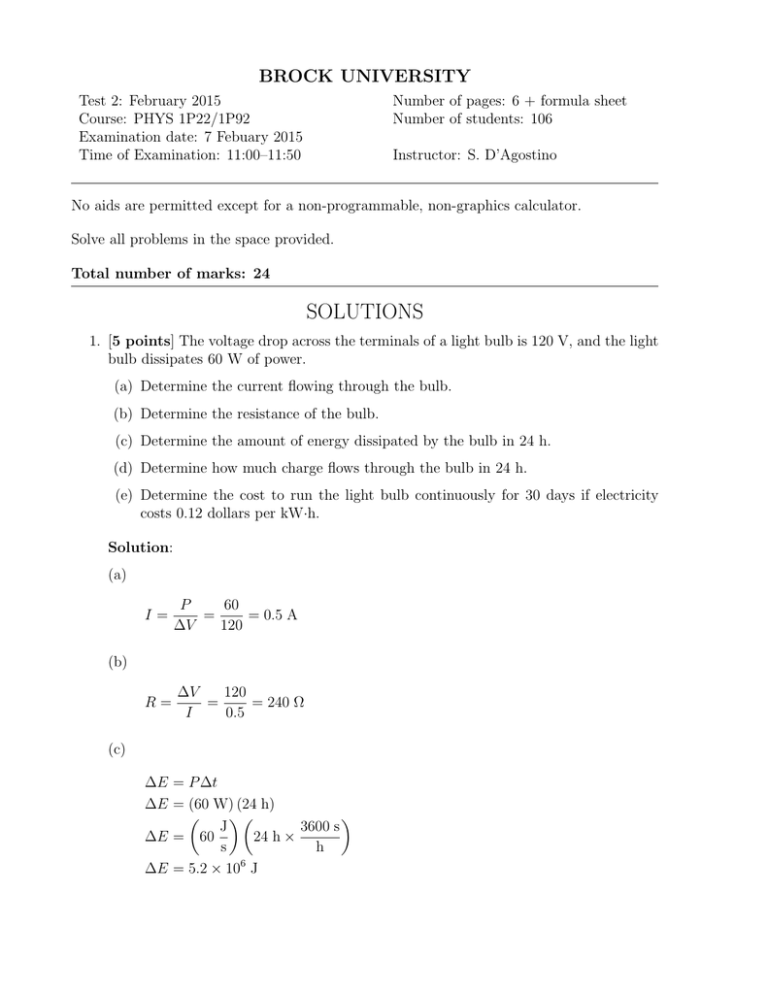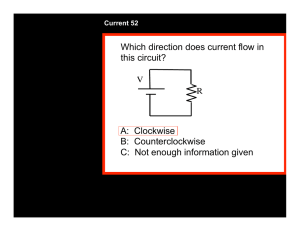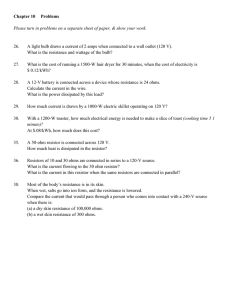solutions - Brock University
advertisement

BROCK UNIVERSITY Test 2: February 2015 Course: PHYS 1P22/1P92 Examination date: 7 Febuary 2015 Time of Examination: 11:00–11:50 Number of pages: 6 + formula sheet Number of students: 106 Instructor: S. D’Agostino No aids are permitted except for a non-programmable, non-graphics calculator. Solve all problems in the space provided. Total number of marks: 24 SOLUTIONS 1. [5 points] The voltage drop across the terminals of a light bulb is 120 V, and the light bulb dissipates 60 W of power. (a) Determine the current flowing through the bulb. (b) Determine the resistance of the bulb. (c) Determine the amount of energy dissipated by the bulb in 24 h. (d) Determine how much charge flows through the bulb in 24 h. (e) Determine the cost to run the light bulb continuously for 30 days if electricity costs 0.12 dollars per kW·h. Solution: (a) I= P 60 = = 0.5 A ∆V 120 R= ∆V 120 = = 240 Ω I 0.5 (b) (c) ∆E = P ∆t ∆E = (60 W) (24 h) J 3600 s ∆E = 60 24 h × s h 6 ∆E = 5.2 × 10 J If you prefer the result in kW·h, which is a more practical energy unit, calculate as follows: ∆E ∆E ∆E ∆E = P ∆t = (60 W) (24 h) = 1440 W · h = 1.44 kW · h (d) ∆Q = I∆t ∆Q = 0.5 A × 24 h ∆Q = 0.5 A × 24 h × 3600 s h ∆Q = 43, 200 C ∆Q = 43.2 kC (e) Cost = 0.12 kW·h $ × 1.44 × 30 days = $5.18 kW·h day 2. [3 points] If a copper wire is replaced by another copper wire that has twice the length and one-third the diameter, how does the resistance change? Solution: The resistance increases by a factor of 18, as the following calculation shows: R2 R1 R2 R1 R2 R1 R2 R1 R2 R1 R2 R1 R2 R1 ρ 2 L2 ρ 1 L1 ÷ A2 A1 ρ 2 L2 ρ 1 L1 = ÷ πr22 πr12 ρ 2 L2 πr12 = × πr22 ρ 1 L1 ρ 2 L2 r2 = 2 × 1 r2 ρ 1 L1 ρ2 L2 r12 = × × ρ1 L1 r22 2 ρ 2 L2 r1 = × × ρ 1 L1 r2 2 1 = (1) × (2) × 1/3 = R2 = (1) × (2) × (3)2 R1 R2 =2×9 R1 R2 = 18 R1 3. [4 points] Determine the equivalent resistance of the circuit. 10 Ω 10 Ω 0 12 20 Ω 50 V 40 Ω 25 Ω Ω 10 Ω 30 Ω Solution: First identify simple series or simple parallel combinations of resistors. In the following diagram I’ve identified two resistors that are in series by printing their labels in red: 10 Ω 12 20 0 10 Ω Ω 50 V 25 Ω 40 Ω Ω 10 Ω 30 Ω Combining the two red resistors in series results in 10+10 = 20 Ω, so these two resistors can be replaced by a single resistor of resistance 20 Ω, as in the following diagram: 10 Ω 20 Ω 0 12 20 Ω 50 V 40 Ω 25 Ω Ω 30 Ω Now combine the two 20-Ω resistors in parallel and replace them by a single resistor of resistance −1 −1 1 1 2 20 + = 10 Ω = = 20 20 20 2 10 Ω 0 12 10 Ω 50 V 40 Ω 25 Ω Ω 30 Ω Now the 10-Ω resistor and the 30-Ω resistor, which are in series, can be combined and replaced by a single resistor of resistance 10 Ω + 30 Ω = 40 Ω 10 Ω 0 12 40 Ω 50 V 40 Ω Ω 25 Ω Next, combine the two 40-Ω resistors, which are in parallel, and replace them by a single resistor of resistance −1 −1 1 1 2 40 + = = = 20 Ω 40 40 40 2 10 Ω 0 12 Ω 50 V 20 Ω 25 Ω Now the 10-Ω resistor and the 20-Ω resistor, which are in series, can be combined and replaced by a single resistor of resistance 10 Ω + 20 Ω = 30 Ω 30 Ω 0 12 Ω 50 V 25 Ω Next, combine the 30-Ω resistor and the 120-Ω resistor, which are in parallel, and replace them by a single resistor of resistance −1 −1 −1 4 5 120 1 1 1 = = = + + = 24 Ω 30 120 120 120 120 5 24 Ω 50 V 25 Ω The equivalent resistance of the circuit can now be determined by combining the remaining two resistors, which are in series, to obtain 24 Ω + 25 Ω = 49 Ω 4. [4 points] Determine the current through each resistor. 10 Ω 10 Ω 50 V 50 V 10 Ω 30 Ω 10 Ω Solution: I have labelled currents as in the following diagram: I1 10 Ω I3 10 Ω I2 50 V 50 V I1 10 Ω I3 30 Ω 10 Ω I3 Using Kirchhoff’s junction law at either of the two labelled junction points, we obtain I2 = I1 + I3 (1) Using Kirchhoff’s loop law in the left loop, we obtain 50 − 10I1 + 50 − 10I1 = 0 which is equivalent to 20I1 = 100 (2) Using Kirchhoff’s loop law in the right loop, we obtain 50 − 10I3 − 30I3 − 10I3 = 0 which is equivalent to 50I3 = 50 (3) Solving equation (2), we obtain I1 = 5 A Solving equation (3), we obtain I3 = 1 A Substituting these results into equation (1), we obtain I2 = I1 + I3 I2 = 5 + 1 I2 = 6 A Clearly state whether each of the following statements is true or false. Then, whether the statement is true or false, explain the situation briefly and clearly, in at most a few sentences. Your explanation may include formulas or diagrams, if you wish. Remember, brevity and clarity are courtesy. 5. [2 points] A bird can safely perch on an uninsulated 10,000-V power line. Solution: TRUE. Because the resistance of the wire is extremely low, the voltage drop between two points on the wire that are very close together is small. The small voltage difference between the bird’s feet drives a very small current through the bird’s body, because the bird’s own resistance is considerably greater than the wire’s resistance. 6. [2 points] According to Ohm’s law, when current flows through a resistor, charge is consumed and converted into thermal energy, which is then dissipated by the resistor. Solution: FALSE. Charge is not consumed; think about the principle of conservation of charge. What actually happens in the resistor is that electric potential energy carried by the electrons is converted to thermal energy, which is then dissipated by the resistor. 7. [2 points] In a series circuit with two resistors connected to a battery, the current in the resistor closer to the negative battery terminal is greater, because some current is consumed as it passes through the first resistor. Solution: FALSE. Current is not consumed; think about the principle of conservation of charge, which is equivalent to Kirchhoff’s junction law. In a series circuit, the current is the same in all parts of the circuit. 8. [2 points] Household circuits are wired in series because in this way less wire is used and so it’s less expensive. Solution: FALSE. Household circuits are wired in parallel, NOT in series. Parallel circuits are used so that the current to each appliance or light bulb is not decreased when several of them are switched on. Furthermore, if your home were wired in series you would not be able to separately control each item included in a circuit; they would have to either all be switched on or all be switched off.






